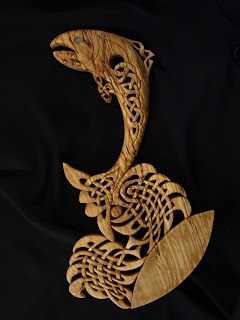This is a leaping salmon with the splashing of water as it jumps rendered in Celtic knotwork fashion. Fish are MUCH harder to do than one would think and when you're trying to make them Celtic to boot, they get even tougher!! I wanted the fish's head to be instantly recognizable as a salmon, so I chose to show it as it would look returning to its spawning grounds, leaping the waterfalls and obstacles which stand in its way. I took more liberty with the body and tail,using the complex knotwork (which Celtic art has become so well known for) to create the fluid details of its fins and skeletal structure.
The waves and splashes were a completely different problem. Here I wanted the knotwork to appear fairly formal while still giving the effect of movement and some sense of the 'random' nature of water splashing around. Not an easy tightrope to balance on, but I think it worked out pretty much as I had hoped it would!
I placed the bowl on a bit of an angle to give it a more 'rocklike' appearance, symbolizing the obstacles the salmon has to overcome on its long journey. For those of you with eagle eyes, the tiny face beneath the salmon's tail represents an egg and the next generation of salmon to make the perilous voyage from stream to ocean and back to the stream again.
The wood I chose for this carving is a glorious piece of birch which displays the beautiful colours of 'spalting'. This colouration comes about when the wood begins its long process of decay, rotting back into the soil to become food for the next generation of trees. As well as lending the piece wonderful movement and colour, the spalting also hints at the cycle of life so aptly illustrated by the salmon.
Lovespoon purists may argue that this spoon isn't a lovespoon because it isn't festooned with the usual hearts and symbols of traditional spoons...I'm going to reply with a well considered, "Bollocks!"
This spoon speaks to tradition, to the ever continuing cycle of life and family and is reverential of the things which make our lives worth living...beauty, simple pleasures, the natural world and love.
So how's THAT for arty farty????
To be really effective, Celtic knotwork needs to be carved from both sides. That helps give it more depth and creates nice shadows when it's hung on the wall. So here's a view from the back. Get a load of that beautiful spalting in the bowl!! Woooohooo!!


What a great dynamic design. The overall shape is an eye-catcher, attractive and interesting. Then a closer look delights more and more.
ReplyDeleteThe celtic knot-work melded into an interplay of fast and slow curves is just superb, as is the utilisation of the particular piece of timber's natural features. The whole sculptural work doesn't read as a lovespoon at first glance but you can see that it most certainly is, as you continue to look.
This is a massive plus in my reckoning and the tradition is served well by innovative designs like this. It is he possibility of such innovation within the tradition that makes lovespoon carving such a worthy and fertile medium for the expression of ideas and emotion.
Is the 'egg' beneath the salmon's tail captured? I've been thinking of including loose captured elements that are securely captured but only just captured, with under cutting by surrounding elements. I'm thinking this would enable a bypassing of some of the design restrictions full cages sometimes impose.
David, this is one of the most beautiful carvings I have ever seen. And for someone like myself who has been working in fisheries for the past few years, this is quite the design. Currently, I am a Peace Corps volunteers serving in Zambia (southern Africa), working in fish farming! When I am back on American soil next month for vacation, I have plans to obtain another tattoo and, if it is alright with you, I would LOVE to use your design. Does that sound alright with you?
ReplyDelete